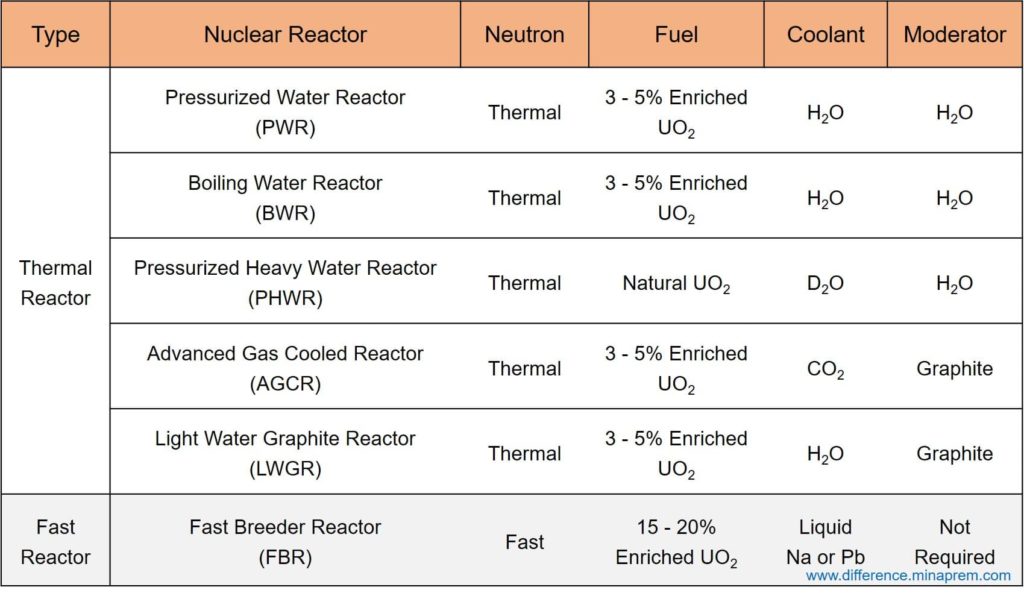Rapid depletion of fossil fuel reserve and unsustainable rate of greenhouse gas emission from the thermal power plants paved the way for accelerated growth of nuclear power plants across the world to meet the evergrowing need of energy requirements. Human have already mastered the nuclear fission technology and thus it is overwhelmingly used in power plants. In the nuclear fission power plants, thermal energy (heat) is generated by the nuclear fission reaction, which is then transferred to a fluid (called coolant) to drive, either directly or indirectly, the steam turbine for generating electricity. Nuclear reactor is a large chamber where nuclear fission reaction is initiated and continued in a controlled rate. Necessary fuel (nuclear fuel) and controlling accessories are kept inside the reactor. Low temperature coolant is continuously pumped into the reactor where the heat generated due to nuclear reaction is transferred to this coolant, and thus high temperature coolant comes out of the reactor. Among the naturally available isotopes of uranium, only the U-235 isotope can sustain the chain reaction. Uranium with higher proportion of U-235 isotopes (i.e. enriched uranium) is commonly used as nuclear fuel for reactors. In order to initiate the nuclear fission reaction, U-235 isotope is required to be bombarded with high velocity neutrons. Based on the characteristics of neutron, fission reactors can be classified into two groups – thermal reactor and fast reactor.
A thermal nuclear reactor is based on thermal neutron (i.e. fission reaction is initiated by thermal neutrons). A thermal neutron remains in thermal equilibrium with the atmospheric molecules at NTP. It possesses 0.025eV of kinetic energy, which is corresponding to about 2.2km/s velocity at 20°C. Such a neutron offers significantly higher fission cross-section (indicates the probability to split one heavier nucleus) towards U-235. Every fission reaction again produces one to seven neutrons (mostly 3), but such neutrons are all fast neutrons. A fast neutron has significantly higher energy as compared to thermal neutron. Fast neutron has 1 – 10MeV energy, which is corresponding to about 50,000km/s velocity at 20°C. But it has very low fission cross-section and thus cannot sustain chain-reaction with low enriched fuel. Accordingly, there exist two possible ways to sustain chain reaction – either reducing velocity of neutrons that are generated from fission reaction, or increasing enrichment of the fuel. In thermal reactors, low enriched fuel is used and thus moderator (like normal water, graphite, etc.) is used for reducing velocity of neutrons that are generated from fission reaction. On the contrary, no moderator is employed in fast reactors, rather high enriched fuel (15 – 20%) is used to compensate for the reduction of fission cross-section of fast neutrons towards U-235. Thus chain reaction is continued in both type of reactors. In thermal reactors, moderator is used to slow down the prompt neutrons to continue chain reaction with low enriched fuel; while in fast reactors, prompt neutrons are directly used to continue chain reaction with high enriched fuel. Various similarities and differences between thermal reactor and fast reactor for nuclear power generation are given below in table format.
Similarities between thermal reactor and fast reactor
- Both are nuclear fission rectors (these are not nuclear fusion reactor).
- Enrichment of natural uranium with U-235 isotopes is required in both type of reactors; however, the percentage of such enrichment varies widely. PHWR can be operated at natural percentage of U-235.
- Chain reaction is very much desired to continue heat generation irrespective of the type of reactor.
- Irrespective of reactor type, the uranium dioxide (UO2) in the form of rod or pallet is commonly used as nuclear fuel.
Differences between thermal reactor and fast reactor
| Thermal Reactor | Fast Reactor |
|---|---|
| In thermal reactors, the fission chain reaction is sustained by the thermal neutrons that have energy of 0.025eV and velocity of 2.2km/s. | In fast reactors, the chain reaction is sustained by fast neutrons that have energy of 1 – 10MeV and velocity of around 50,000km/s. |
| Moderation is required to slow down the prompt neutrons produced in one fission reaction in order to make such neutrons suitable for further fission. | No such moderation is required as fission is sustained by the fast neutrons. |
| Based on the design, thermal reactors utilize either light water (H2O), or heavy water (D2O) or carbon dioxide (CO2) as coolant. | Fast reactors utilize liquid metal (liquid sodium or liquid lead) as coolant. |
| Thermal reactors require low enriched fuel. Typically light water based reactors and gas cooled reactors require 3 – 5% enrichment, while heavy water based reactors require no enrichment (i.e. natural uranium can be used as fuel). | Fast reactors require comparatively high enrichment to increase chances of fission by fast neutrons. Fast reactor fuels are usually 15 – 20% enriched. |
| Nuclear breeding does not take place in thermal reactors. | Nuclear breeding occurs in fast breeder reactors (FBR), where a portion of fertile material gets converted into fissile materials (and thus produce more fuel). This can reduce dependency on inadequately available U-235. |
| Thermal reactors generate large radioactive waste. | Fast reactors help reducing radioactive waste by continuously disintegrating heavier isotopes. |
| Conversion Ratio or Breeding Ratio for a thermal reactor remains in between 0.3 and 0.7 (0.3 ≤ CR ≤ 0.7). | Breeding Ratio of a fast reactor is maintained higher than 1. |

References
- Fundamentals of Nuclear Reactor Physics by E. E. Lewis (2008, Academic Press).
- Physics of High-Temperature Reactors by L. Massimo (1976, Pergamon Press).